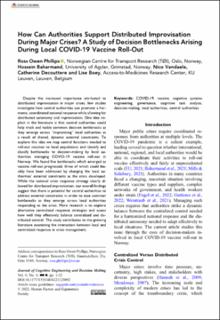| dc.contributor.author | Phillips, Ross Owen | |
| dc.contributor.author | Baharmand, Hossein | |
| dc.contributor.author | Vandaele, Nico | |
| dc.contributor.author | Decouttere, Catherine | |
| dc.contributor.author | Boey, Lise | |
| dc.coverage.spatial | Norway, Oslo | en_US |
| dc.date.accessioned | 2023-06-15T07:10:57Z | |
| dc.date.available | 2023-06-15T07:10:57Z | |
| dc.date.created | 2022-11-23T10:02:49Z | |
| dc.date.issued | 2022-11-11 | |
| dc.identifier.citation | Journal of Cognitive Engineering and Decision Making Volume 17, Issue 2, 166 - 187 | |
| dc.identifier.issn | 1555-3434 | |
| dc.identifier.uri | https://hdl.handle.net/11250/3071477 | |
| dc.description.abstract | Despite the increased importance attributed to distributed improvisation in major crises, few studies investigate how central authorities can promote a harmonic, coordinated national response while allowing for distributed autonomy and improvisation. One idea implicit in the literature is that central authorities could help track and tackle common decision bottlenecks as they emerge across “improvising” local authorities as a result of shared, dynamic external constraints. To explore this idea we map central functions needed to roll-out vaccines to local populations and identify and classify bottlenecks to decision-making by local authorities managing COVID-19 vaccine roll-out in Norway. We found five bottlenecks which emerged as vaccine roll-out progressed, three of which could feasibly have been addressed by changing the local authorities’ external constraints as the crisis developed. While the national crisis response strategy clearly allowed for distributed improvisation, our overall findings suggest that there is potential for central authorities to address external constraints in order to ease common bottlenecks as they emerge across local authorities responding to the crisis. More research is to explore alternative centralized response strategies and assess how well they effectively balance centralized and distributed control. The study contributes to the growing literature examining the interaction between local and centralized response in crisis management. | en_US |
| dc.language.iso | eng | en_US |
| dc.publisher | SAGE Publications | en_US |
| dc.rights | Navngivelse-Ikkekommersiell 4.0 Internasjonal | * |
| dc.rights.uri | http://creativecommons.org/licenses/by-nc/4.0/deed.no | * |
| dc.subject | COVID-19 | en_US |
| dc.subject | vaccine | en_US |
| dc.subject | cognitive systems engineering | en_US |
| dc.subject | governance | en_US |
| dc.subject | cognitive task analysis | en_US |
| dc.subject | decision-making | en_US |
| dc.subject | local authorities | en_US |
| dc.subject | central authorities | en_US |
| dc.title | How Can Authorities Support Distributed Improvisation During Major Crises? A Study of Decision Bottlenecks Arising During Local COVID-19 Vaccine Roll-Out | en_US |
| dc.title.alternative | How Can Authorities Support Distributed Improvisation During Major Crises? A Study of Decision Bottlenecks Arising During Local COVID-19 Vaccine Roll-Out | en_US |
| dc.type | Journal article | en_US |
| dc.type | Peer reviewed | en_US |
| dc.rights.holder | © 2022, Human Factors and Ergonomics Society | en_US |
| dc.description.version | publishedVersion | en_US |
| cristin.ispublished | true | |
| cristin.fulltext | original | |
| cristin.qualitycode | 1 | |
| dc.identifier.doi | 10.1177/15553434221125092 | |
| dc.identifier.cristin | 2078930 | |
| dc.source.journal | Journal of Cognitive Engineering and Decision Making | en_US |
| dc.source.volume | 17 | en_US |
| dc.source.issue | 2 | en_US |
| dc.source.pagenumber | 166-187 | en_US |

